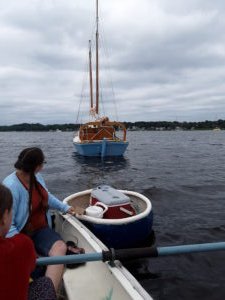
For about a week after the first failed launch of Pshrimp that I told you about in the last post, we turned our hands to other things: a quick weekend to New Hampshire, some work around the house—but the problem of giving Pshimp time to take up and stop sinking was always in our minds. There was only one thing to do: put her in and keep someone aboard to pump every so often until she stopped taking on water so fast. But I couldn’t break away from work for that long, and she’s too small for the whole family to be out there together for days on end.

We finally sorted out a plan in which the children would take a day each to stay onboard, and I would join them after work each evening and spend the night aboard. Taking the first Monday off of work, our longsuffering friend with the big truck came early in the morning and down we went to the launch ramp again.
There’s a lot to rig up, with two masts and all the usual tangle of shrouds and halyards, but we got it all on at last, put the engine in gear, and cast off for the first time. The launch ramp we used is under a bridge, and getting out required stemming the incoming tide for a couple hundred feet until clear of a piling, then aiming for mid-channel before the flood could beat you broadside into it.

That potential crisis past, I started hoisting sails, only to hear the engine revolutions drop. I had discovered that the solution was to pump a little primer mechanism on the fuel filter: still working ancient fuel out of her system, the engine had to be helped past the occasional clot of scunge. A few quick strokes did the trick, and I was barely back at the halyards when yells of dismay heralded another disaster.

We were towing three tenders just then: the big dinghy for all of us to get ashore from the mooring, if we ever got there, and Emily and Damaris’ coracles. One of the coracles, buffeted by the tide’s wash as it squeezed between the last constriction of the basin, had put her gunwale under and filled, and we were towing her more as a drogue than a dinghy. Luckily coracles are light, and I was able to haul it in close and flip it out of the water, leaving most of that behind. Meanwhile, the fuel needed pumpig again, and the foresail was still only half-hoisted.
It was a busy few minutes, but before we had cleared Common Fence Point to head across the open bay, everything was settling in. With the sails set and drawing, I shut the engine down; the coracles were tied up short so the gunnels couldn’t dip; and the breeze had filled in nicely.

It was a glorious sail across Mt. Hope Bay to the Kickemuit river, and very satisfying not only to shoot the Bristol Narrows under sail, but to pick up our mooring with no drama under mainsail alone. That night Damaris began the watch rotation with me, and we pumped every few hours, noting here and there where water was visibly coming in. Arriving at Pshrimp after work the next day, Antigone greeted me with the news that there was barely anything to pump any more.

We took a sail around the bay, ate our supper at the mooring, and turned in, noting the time since the last pump. I wanted to see how long before the float-switch bilge pump came on. Eight hours later, we finally heard the pump cut on, run for fifteen seconds, then turn off. Not bad. If it only had to cycle three times a day, the small solar panel I’d hooked up to the battery should be able to keep up.
It was Emily’s turn next day, and then I’d be able to return home and shower for the first time in four days. An afternoon thunderstorm was brewing in the offing as we cooked supper on the camp stove in the cockpit (there’s simply no room for cooking inside), and we had barely cleaned up when our first big storm aboard forced us inside to play cards while the squall raged outside. Opening the leeward portholes against stuffiness, we watched lightning flicker all around while rain drummed on the cabintop and the thunder clapped its hands not very far away at all. Through it all, Pshrimp lay rock-solid to her mooring, her hard-chined bottom barely heeling to the gusts. It was most satisfying.



Ever since that first week, we’ve hardly missed a chance to take her out for an after-work sail when the tide is right, or an overnighter if the weekend doesn’t have more pressing plans. She’s an easy boat to sail, and even if she doesn’t pick up and go like bigger boats, she has a dry and comfy cockpit, and gets you across the bay without tipping your coffee and splashing your sandwiches. And for a daysailer, what more could you possibly want?

